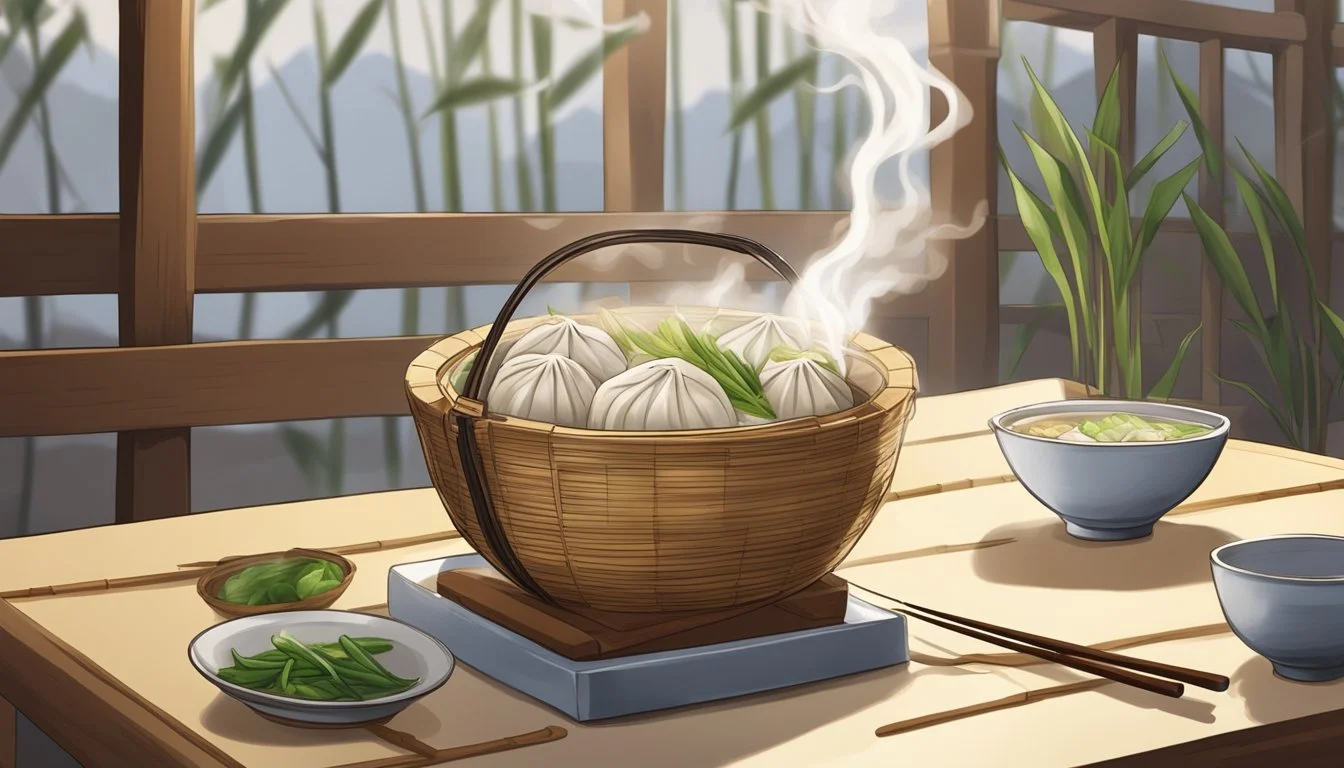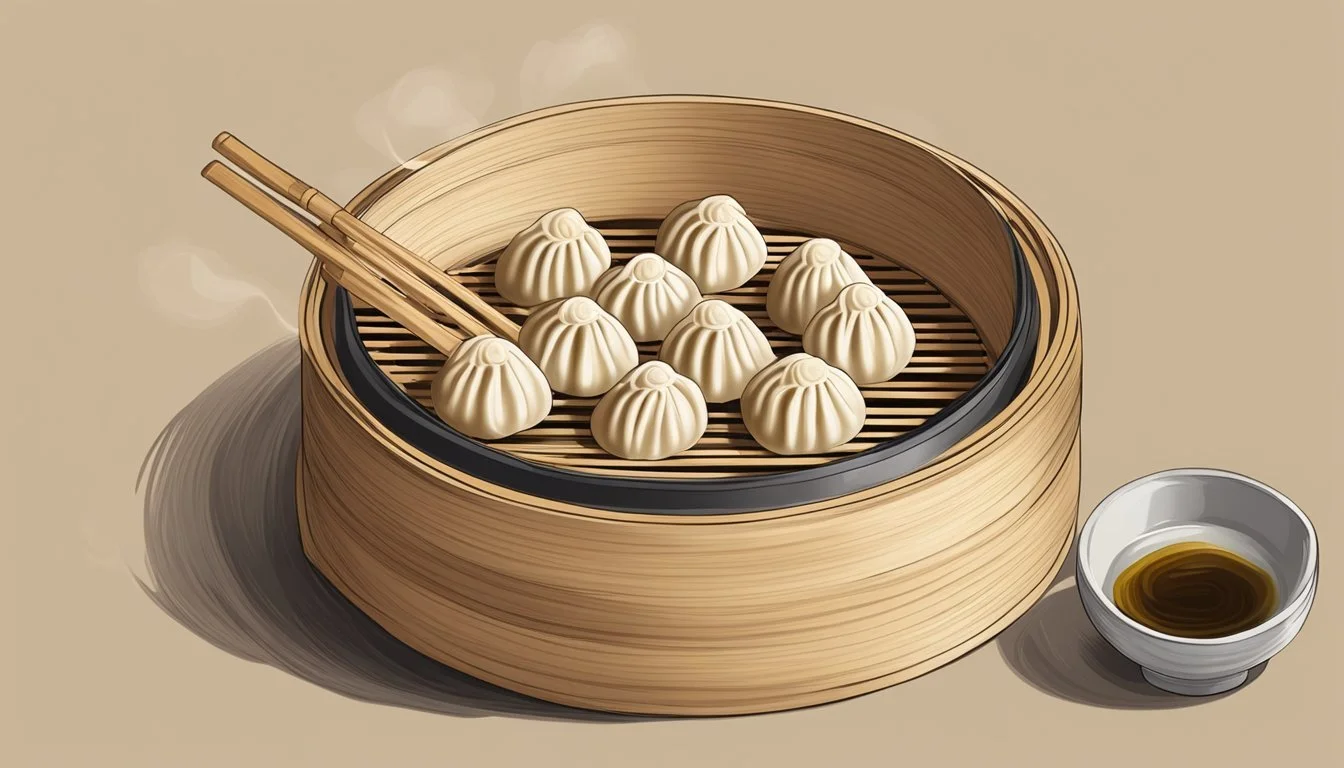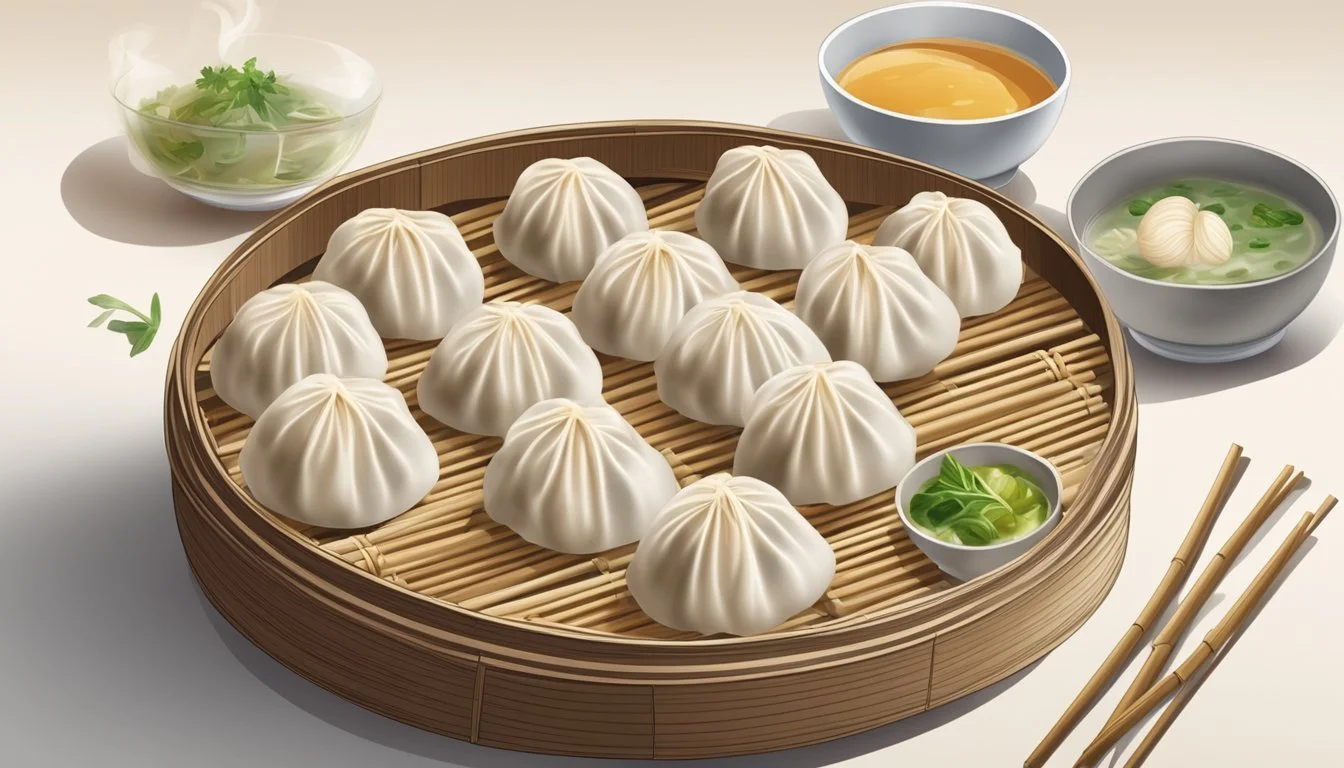Best Way to Reheat Xiaolong Bao
Ensuring Tender Wrappers and Piping Hot Soup
Xiaolongbao, or soup dumplings, are a culinary delight that originated from the Jiangnan region of China, particularly associated with Shanghai and Wuxi. Renowned for their delicate skin and flavorful broth filling, these dumplings are traditionally steamed in bamboo baskets and served fresh. However, once they've cooled down or been refrigerated, the challenge is to reheat these morsels without compromising their signature tender wrapper and delectable, steamy soup contained within.
Reheating xiaolongbao requires a method that respects their delicate nature. The goal is to ensure that the wrapper does not become too tough or too soggy, while also ensuring that the soup inside is heated to the right temperature. A common mistake when reheating xiaolongbao is overheating, which risks rupturing the carefully crafted dough and losing the soup that is the essence of this dish. Steaming remains a top method for bringing these dumplings back to their near-original state. Using a method that mimics the original cooking process, the xiaolongbao can retain the intended textures and flavors that make them so enjoyable.
Understanding Xiaolongbao
Xiaolongbao, commonly known as soup dumplings, are a culinary marvel combining tender dumpling wrappers with flavorful soup and meat filling. This section delves into their historical roots and the intricacies of their composition.
History and Cultural Significance
Xiaolongbao originated from the Jiangnan region of China, particularly associated with Shanghai and the surrounding areas. These steamed dumplings have a storied past that dates back to the late 19th century. Recognized for their intricate preparation and unique eating experience, xiaolongbao have garnered global popularity extending beyond their traditional cultural confines. In Chinese cuisine, they exemplify the art of dough craft and balance of flavors that are central to regional gastronomy.
Ingredients and Dumpling Anatomy
Dumpling Wrappers:
Material: Thinly rolled dough primarily made from flour and water.
Filling:
Protein: Commonly ground pork, sometimes chicken, shrimp, or vegetables for alternative variations.
Binder: Gelatin, usually derived from pork skin, that liquefies upon steaming, creating the soup within.
Seasoning:
Consistency: A mix of ginger, green onion, sesame oil, and white pepper is frequently used to season the meat filling, providing depth and warmth.
Soup Creation:
Prepare a seasoned broth.
Incorporate gelatin into the broth.
Allow the mixture to set and then incorporate it into the dumpling filling.
Dipping Sauce:
Ingredients: Typically includes soy sauce and ginger for a tangy, savory compliment to the rich flavors of the dumplings.
Through understanding the heritage and construction of xiaolongbao, one gains appreciation for the culinary finesse they represent and can better appreciate the importance of proper reheating techniques to maintain their integrity.
Proper Storage for Xiaolongbao
Proper storage is crucial for maintaining the texture and flavor of Xiaolongbao leftovers. Following the right cooling and freezing guidelines ensures that these delicate soup dumplings can be enjoyed later with their quality preserved.
Cooling and Storing Leftovers
Once Xiaolongbao have cooled to room temperature, they should be placed in an airtight container to prevent them from drying out. This container must then be refrigerated promptly. It is important to store them flat to avoid any unnecessary pressure on the dumplings that could cause them to break open and lose their broth. The refrigerator provides the ideal environment to keep the Xiaolongbao fresh for up to two to three days.
Step 1: Let dumplings cool to room temperature
Step 2: Place in an airtight container
Step 3: Refrigerate immediately
Freezing Guidelines
For long-term storage, freezing is an effective method. One should carefully place the Xiaolongbao in a single layer inside a freezer bag, separating each dumpling with parchment paper to prevent sticking. They should be frozen as soon as possible after they have cooled down to sustain their quality. This stops the wrapper from becoming tough and preserves the soup inside. Soup dumplings can be kept frozen for up to one month.
Step 1: Cool dumplings to room temperature
Step 2: Place dumplings on parchment paper in a single layer
Step 3: Transfer to a freezer bag, then seal and freeze immediately
Safe Reheating Techniques
To maintain the tenderness of the wrapper and ensure the soup within Xiaolong Bao remains hot, it is crucial to use methods that gently reheat without overcooking. Here are the most reliable techniques.
Reheating in a Steamer
Steaming is the preferred method to reheat soup dumplings like Xiaolong Bao. A bamboo steamer lined with parchment paper can preserve the texture of the dumpling wrapper. They should be steamed for 5-8 minutes or until thoroughly heated.
Fill a pot with water: Ensure it's 1-2 inches below the steamer.
Preheat: Bring the water to a simmer.
Prepare the steamer: Line with parchment paper.
Place dumplings: Set Xiaolong Bao in steamer without overcrowding.
Steam: Cover and heat for the recommended time.
Microwave Reheating Method
Reheating in a microwave requires careful monitoring to prevent the dumplings from becoming too tough. Place the dumplings on a microwaveable dish, cover them with a damp paper towel, and use a medium setting.
Set dumplings on a microwaveable plate.
Cover with damp paper towel: This keeps moisture in.
Heat at 50% power in 10-second bursts.
Pan Frying to Reheat
To reheat pan-fried dumplings such as potstickers, use a skillet to achieve a crisp exterior while warming the interior. A small amount of water can be added to assist in creating steam.
Lightly oil a skillet: Use medium heat.
Place dumplings: Lay them in a single layer.
Cover and fry: Add a few tablespoons of water if necessary for steam.
Oven or Baking Method
Baking can be an alternate method to reheat both steamed dumplings and potstickers. Use a preheated oven and place the dumplings on a baking sheet to encourage even reheating.
Preheat oven: Aim for a temperature of 350°F.
Prepare baking sheet: Optionally line with parchment.
Arrange dumplings: Ensure space between them for even heat distribution.
Heat: Place in oven for a few minutes, checking frequently.
Troubleshooting Common Reheating Issues
When reheating Xiaolong Bao, specific challenges may affect the quality of the dumplings. This section addresses methods to prevent wrapper toughness and ensure the broth within the dumplings is evenly heated.
Preventing Wrapper Toughness
Cabbage Leaves: Lining the steamer with cabbage leaves can prevent the dumplings from sticking and assist in preserving the tenderness of the wrappers. This method provides a barrier between the steamer and the dumplings, reducing direct contact with intense heat which can toughen the wrapper.
Use of Oil:** A light brush of oil on dumplings before steaming can also prevent stickiness and maintain wrapper tender. However, be cautious with the amount to avoid making the dumplings greasy.
Ensuring Even Warmth of the Broth
Steam Duration: Steaming Xiaolong Bao for an appropriate time is crucial. Generally, steaming for 5-8 minutes should sufficiently heat the broth without overcooking the wrapper. Adjust steaming time based on the size of the dumplings and starting temperature (frozen vs. refrigerated).
Boiling Water: Ensure the water is at a rolling boil before placing the dumplings in the steamer. Even and consistent steam is essential for heating the dumplings thoroughly, thus achieving hot and liquid broth.
Monitoring:* Regularly check the dumplings to avoid over-steaming, which can impact the tenderness of the wrap and the integrity of the soup within. Additionally, adding too much water in the steamer can lead to soggy wraps, so it's important to keep the water level beneath the steamer rack.
Pairing and Serving Suggestions
When reheating Xiaolong bao (soup dumplings), one should focus on the dipping sauce and accompaniments to heighten the dining experience. A great pairing accentuates the delicate flavors of the dumpling and adds a layer of complexity.
Dipping Sauce Varieties
Traditional Dipping Sauce:
Ingredients: Equal parts soy sauce and black vinegar, with minced ginger to taste.
Preparation: Combine the ingredients in a small bowl.
Sesame-Ginger Sauce:
Ingredients: Sesame oil, soy sauce, black vinegar, finely chopped ginger, and a dash of sugar.
Preparation: Whisk together adding sesame oil judiciously for a fragrant twist.
Accompaniments
Fresh Herbs:
Serve: Chopped green onions sprinkled on top of or alongside the dumplings.
Dumpling's Best Friend:
Pairing: A small dish of thinly sliced ginger to cleanse the palate between bites.
The sauces should be served in separate bowls to allow diners to mix their dips to their personal taste. A well-prepared accompaniment creates a harmonious balance with the reheated Xiaolong bao, completing the sensory experience.
FAQs on Reheating Xiaolongbao
When it comes to reheating Xiaolongbao, the goal is to maintain the delicate wrapper while ensuring the broth inside remains flavorful and piping hot. This FAQ section tackles common concerns when reheating these traditional Chinese soup dumplings.
Can You Reheat Xiaolongbao More Than Once?
Reheating Xiaolongbao multiple times is not advisable. The wrapper can become tough, and the soup may lose its rich taste. It is recommended to reheat only the amount you plan to consume to preserve quality and enjoy the dish as intended.
Are There Different Reheating Methods for Various Fillings?
Yes, different fillings can affect the reheating method. While Xiaolongbao (soup dumplings), Shumai, Baozi, and Guo Tie are all types of dumplings, they have different textures and fillings:
Xiaolongbao: Steaming is the best method to maintain the soup inside and tender wrapper.
Shumai: Steaming is also preferable as it retains the moisture of the pork and shrimp filling.
Baozi (steamed buns): A steam-based method is ideal to keep the bread soft and the filling moist.
Guo Tie (potstickers): Reheating in a pan with a small amount of water can help maintain the crispy bottom and avoid drying out the filling.
One should tailor the reheating approach to the type of dumpling to achieve the best texture and flavor.
How to Ensure Safety When Reheating
To reheat Xiaolongbao safely, follow these tips:
Steam for 2-5 minutes or until fully hot throughout.
Use thermometers to check for an internal temperature of 165°F to ensure food safety.
Avoid microwave reheating as it can unevenly distribute heat and affect texture.
By adhering to these methods, one can safely enjoy reheated Xiaolongbao without compromising on quality or safety.
Conclusion
Reheating Xiaolong Bao, or soup dumplings, requires a careful approach to preserve their delicate structure and ensure a piping hot soup filling. Steaming is the best method, offering a balance of heat and moisture that is crucial for maintaining the tenderness of the wrapper and the integrity of the hot soup inside.
To reheat, the dumplings should be placed in a steamer lined with parchment paper, cabbage, or lettuce leaves to prevent sticking. A bamboo steamer is optimal, but any steamer that fits will work. The water must be brought to a boil before the dumplings are placed in the steamer.
Here is a brief outline of the process:
Line the steamer
Boil water in a pot
Place dumplings in the steamer
Cover and heat for 6-8 minutes
Heating for 6-8 minutes is usually sufficient, but one should always check to see if the dumplings are thoroughly warmed through. It's recommended to prepare a few extra dumplings, as occasionally some may split during the reheating process.
Consumers can take confidence in this reheating technique, as it is widely endorsed for its effectiveness in retaining the qualities that make Xiaolong Bao a culinary delight. This method works well with both frozen and refrigerated dumplings, guaranteeing that one can enjoy their Xiao Long Bao as if they were freshly made.




